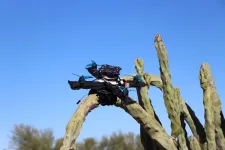(Press-News.org) ST. LOUIS – Research published in Regional Environmental Change has shown that as climate zones shift toward hotter and drier conditions, ecological diversity will decline, posing a major threat to terrestrial ecosystems with far-reaching social and ecological impacts.
The study, “Shifting climate zones and expanding tropical and arid climate regions across Kenya (1980-2020),” was published online on April 5.
The research team analyzed Kenya's geographic distribution and arrangement of climate zones between 1980-2020. Over that time, tropical climate regions expanded from 91 to 93% with over 13,000 square kilometers shifting from alpine and temperate regions to tropical ones, and arid climate regions expanded from 72 to 81%, a roughly 50,000 km2 shift from humid and semi-humid-to-semi-arid to arid regions.
“With a better understanding of how climate shifts occurred in an environment like Kenya, we can estimate how food security will be impacted in other regions with similar geographic patterns,” said Enbal Shacham, Ph.D., professor of behavioral science and health education at Saint Louis University’s College for Public Health and Social Justice and acting director of strategic initiatives for the Taylor Geospatial Institute.
The first author is Ted J. Lawrence, a former post-doctoral fellow at the Taylor Geospatial Institute. Shacham is the paper’s senior author.
The research team looked at how temperature and precipitation trends changed over time and how the geographic distribution and arrangement of climate zones in Kenya shifted due to those trends.
The team focused on Kenya because rain-fed agriculture is central to the country’s economy and it is a key food-producing country for the East African region. The findings highlight the urgent need for adaptation strategies that take into account the impacts of shifting climate zones on food security and the livelihoods of millions of people. They also underscore the importance of developing land use and ecosystem management practices that can help mitigate the impact of climate change and maintain ecological diversity.
Data showed that in addition to the 1-degree Celsius increase in temperature, there was a decrease in precipitation during the country’s primary rainy season (Spring) and an increase in precipitation in the secondary rainy season (Fall).
An area of 76,346 square kilometers shifted from cooler to hotter zones, while 1,298 square kilometers shifted from hotter to cooler zones. Human-induced climate change significantly alters the spatial-temporal patterns of climate zones, driving agricultural land use and ecosystem change. Changes to the climate zone alter the biological and physical properties of the ecosystem, leading to a change in what an ecosystem can support.
The researchers reviewed data from a variety of sources, including:
Average monthly and annual temperature precipitation time series of Kenya between 1975 and 2020, obtained from the Climate Change Knowledge Portal
Georeferenced average monthly temperature and precipitation across Kenya with a 5-kilometer resolution during 1976-1980, 1996-2000 and 2016-2020 from the TerraClimate dataset
A digitized version of the georeferenced boundaries of the Kenyan ACZs documented in 1982 and obtained through the IGAD Climate Prediction and Application Centre Portal.
The team assessed the average annual and seasonal temperature and precipitation trends to understand Kenyan climate change between 1975-2020 before creating climate reference maps. The maps represented temperature and precipitation zones in 1980, 2000 and 2020.
Human-induced climate change in Kenya resembles global trends, the research found, with certain regions being more sensitive to the forces of climate change.
As climate zones shift toward hotter and drier conditions, ecological diversity will decline, posing a major threat to terrestrial ecosystems with far-reaching social and ecological impacts.
Information on climate change and shifting climate zones in this paper can be used to investigate a variety of ecological questions and aid in the effort to reach the United Nations’ Sustainable Development Goals.
Additional authors include Justin M. Vilbig, a geospatial data scientist in SLU’s Department of Earth and Atmospheric Sciences and TGI; Geoffrey Kangogo, a Ph.D. student in SLU’s College for Public Health and Social Justice; Eric M. Fevre, University of Liverpool, UK, and International Livestock Research Institute, Kenya; Sharon L. Deem, Institute for Conservation Medicine at the Saint Louis Zoo; Ilona Gluecks, International Livestock Research Institute, Kenya; and Vasit Sagan, Ph.D., associate professor of Earth and Atmospheric Sciences at Saint Louis University and acting director of TGI.
This work was supported in part by the Taylor Geospatial Institute and a seed research grant from the Living Earth Collaborative at Washington University in St. Louis. Furthermore, this research was also supported in part by the UK Biotechnology and Biological Sciences Research Council, the Department for International Development, the Economic & Social Research Council, the Medical Research Council, the Natural Environment Research Council, and the Defence Science & Technology Laboratory, under the Zoonoses and Emerging Livestock Systems (ZELS) programme, grant reference BB/L019019/1.
This study also received support from the CGIAR One Health initiative “Protecting Human Health Through a One Health Approach,” which was supported by contributors to the CGIAR Trust Fund. The authors thank the University of Liverpool’s Open Access team for support of the CC-BY open access license for this article.
The TGI consortium includes Saint Louis University, the Donald Danforth Plant Science Center, Harris-Stowe State University, University of Illinois Urbana-Champaign, Missouri University of Science & Technology, University of Missouri-Columbia, University of Missouri-St. Louis, and Washington University in St. Louis. Collectively, these institutions encompass more than 5,000 faculty and 100,000 students.
TGI aims to advance geospatial science through multi-institutional, interdisciplinary collaborations to create innovative, real-world solutions to grand societal challenges. It supports a collaborative research and training environment and while shaping the future of geospatial science in the U.S.
Saint Louis University
Founded in 1818, Saint Louis University is one of the nation’s oldest and most prestigious Catholic institutions. Rooted in Jesuit values and its pioneering history as the first university west of the Mississippi River, SLU offers more than 13,500 students a rigorous, transformative education of the whole person. At the core of the University’s diverse community of scholars is SLU’s service-focused mission, which challenges and prepares students to make the world a better, more just place.
END
New study finds shifting climate regions leading to hotter, drier conditions across Kenya
Findings have significant implications for agricultural land use and ecosystem management and highlight the urgent need for climate adaptation strategies in Kenya
2023-04-20
ELSE PRESS RELEASES FROM THIS DATE:
Using solar farms to generate fresh desert soil crust
2023-04-20
In the arid regions of the American Southwest, an unseen world lies beneath our feet. Biocrusts, or biological soil crusts, are communities of living organisms. These industrious microbes include cyanobacteria, green algae, fungi, lichens, and mosses, forming a thin layer on the surface of soils in arid and semi-arid ecosystems.
Biocrusts play a crucial role in maintaining soil health and ecosystem sustainability, but they are currently under assault. Human activities including agriculture, urbanization, and off-road ...
COVID-19 pandemic saw major increase in children and adolescents attempting suicide by poison, study finds
2023-04-20
The rate of suspected suicide attempts by poisoning among children and adolescents ages 10-19 reported to U.S. poison centers increased 30% during 2021 – the COVID-19 pandemic’s first full year – compared with 2019, a new UVA Health study found.
The rate of suspected suicide attempts by poisoning among children ages 10-12 increased 73% during 2021 compared with 2019. Among adolescents ages 13-15, the rate of suspected suicide attempts by poisoning increased 48.8% in 2021 versus 2019. The rate of suspected suicide attempts by poisoning among females ages 10-19 increased 36.8% in 2021 compared with 2019.
The findings ...
Pairing up: the impact of treating alcohol use disorder and PTSD together
2023-04-20
A collaborative multi-site randomized controlled trial at the University of Houston and the Medical University of South Carolina is set to prove the effectiveness of treating alcohol use disorder (AUD) and posttraumatic stress disorder (PTSD) together.
It’s a one-two punch whose time has come. No integrative treatment combining Cognitive processing therapy (CPT) for PTSD and relapse prevention (RP) for AUD currently exists.
“A substantial proportion of individuals with AUD also meet criteria for PTSD. The co-occurrence of AUD/PTSD is characterized by more severe symptomatology, greater functional impairment, ...
IU cancer researchers identify new target for breast cancer therapy
2023-04-20
INDIANAPOLIS—While trying to understand what initiates breast cells to become cancerous, researchers at the Vera Bradley Foundation Center for Breast Cancer Research at Indiana University Melvin and Bren Simon Comprehensive Cancer Center have identified a new target for breast cancer treatment.
“When comparing healthy breast tissue and cancerous cells, we wanted to find out what is the earliest genomic change that happens to initiate the cancer,” said Harikrishna Nakshatri, PhD, the Marian J. Morrison professor of breast cancer research ...
Hungry eyes: Spiders lose vision when they're starving
2023-04-20
Biologists at the University of Cincinnati discovered that underfed jumping spiders lose light-sensitive cells that are key to their vision.
UC College of Arts and Sciences Professor Elke Buschbeck and her co-authors studied photoreceptors in the eyes of bold jumping spiders, tiny eight-legged predators found across North America. The little hunters rely on their keen vision to stalk prey.
But researchers found that underfed spiders begin to lose photoreceptors that give them such good eyesight. Their findings could improve our understanding of ...
Cleveland Clinic research predicts cancer patients’ response to chemotherapy agent cisplatin
2023-04-20
Researchers at Cleveland Clinic have taken an important step in predicting which treatment will work for individual cancer patients. Using a gene signature developed from cell lines and human tissue, the research team demonstrated the ability to predict a patient’s response to the chemotherapy agent cisplatin, without relying on changes in the mutational status of a patient’s cancer. The study was recently published in NPJ Precision Oncology.
In recent years, effective new cancer treatments have ...
Built to bounce back
2023-04-20
Search and rescue efforts following disasters like the massive earthquakes in Turkey and Syria are a race against time. Emergency response teams need to quickly identify voids or spaces in building rubble where survivors might be trapped, and before natural gas leaks, water main flooding or shifting concrete slabs take their toll.
Advanced technology plays a vital role in these recovery operations. Thermal imaging equipment and sensitive listening devices are deployed to seek out signs of life. Small aerial ...
bioRxiv and PaperPlayer pilot a new feature to increase accessibility
2023-04-20
Cold Spring Harbor Laboratory announced today that its life sciences preprint server bioRxiv has partnered with PaperPlayer, a service for converting manuscripts into high-quality audio, to provide audio versions of preprint abstracts in the bioRxiv Neuroscience category. This new feature increases content accessibility and offers a way of obtaining information from preprints that’s an alternative to a screen. It is being piloted in the Neuroscience category to assess its value for preprint users.
"This ...
AI system can generate novel proteins that meet structural design targets
2023-04-20
MIT researchers are using artificial intelligence to design new proteins that go beyond those found in nature.
They developed machine-learning algorithms that can generate proteins with specific structural features, which could be used to make materials that have certain mechanical properties, like stiffness or elasticity. Such biologically inspired materials could potentially replace materials made from petroleum or ceramics, but with a much smaller carbon footprint.
The researchers from MIT, the MIT-IBM Watson AI Lab, and Tufts University employed a generative model, which is the same type of machine-learning model architecture ...
Why are networks stable?
2023-04-20
A single species invades an ecosystem causing its collapse. A cyberattack on the power system causes a major breakdown. These type of events are always on our mind, yet they rarely result in such significant consequences. So how is it that these systems are so stable and resilient that they can withstand such external disruptions? Indeed, these systems lack a central design or blueprint, and still, they exhibit exceptionally reliable functionality.
In the early 70s the field of ecology was split on the question of whether biodiversity is a good or a bad thing for an ecosystem. In 1972 Sir Robert May showed, mathematically, that an increase in biodiversity causes less ecological ...
LAST 30 PRESS RELEASES:
Urban wild bees act as “microbial sensors” of city health.
New study finds where you live affects recovery after a hip fracture
Forecasting the impact of fully automated vehicle adoption on US road traffic injuries
Alcohol-related hospitalizations from 2016 to 2022
Semaglutide and hospitalizations in patients with obesity and established cardiovascular disease
Researchers ‘listen in’ to embryo-mother interactions during implantation using a culture system replicating the womb lining
How changing your diet could help save the world
How to make AI truly scalable and reliable for real-time traffic assignment?
Beyond fragmented markets: A new framework for efficient and stable ride-pooling
Can shape priors make road perception more reliable for autonomous driving?
AI tracks nearly 100 years of aging research, revealing key trends and gaps
Innovative techniques enable Italy’s first imaging of individual trapped atoms
KIER successfully develops Korea-made “calibration thermoelectric module” for measuring thermoelectric device performance
Diversifying US Midwest farming for stability and resilience
Emphasizing immigrants’ deservingness shifts attitudes
Japanese eels, climate change, and river temperature
Pusan National University researchers discover faster, smarter heat treatment for lightweight magnesium metals
China’s 2024 Gastroenterology Report: marked progress in endoscopy quality and disease management
Pusan National University researchers uncover scalable method for ultrahigh-resolution quantum dot displays
Researchers use robotics to find potential new antibiotic among hundreds of metal complexes
Gut bacteria changes at the earliest stages of inflammatory bowel disease
Scientists develop new way to “listen in” on the brain’s hidden language
Brain research: “Pulse generators” grow and shrink as memories are formed
For teens, any cannabis use may have impact on emotional health, academic performance
School meals could unlock major gains for human and planetary health
Menopause hormone therapy does not appear to impact dementia risk
Signature patterns of brain activity may help predict recovery from traumatic brain injury
Dresden study uncovers new key mechanism in cancer cells
New species are now being discovered faster than ever before, study suggests
Cannabis-based products show limited short-term benefit for chronic pain, with increased risk of adverse effects
[Press-News.org] New study finds shifting climate regions leading to hotter, drier conditions across KenyaFindings have significant implications for agricultural land use and ecosystem management and highlight the urgent need for climate adaptation strategies in Kenya



